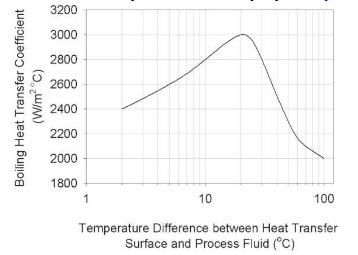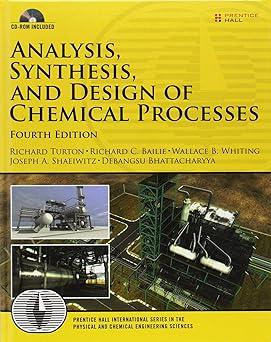During the design of a new separation system, a reboiler using throttled and desuperheated lowpressure steam (
Question:
During the design of a new separation system, a reboiler using throttled and desuperheated lowpressure steam ( 5 barg, \(T_{\text {sat }}=160^{\circ} \mathrm{C}\) ) was specified. The details of this design are given below: Duty \(=5000 \mathrm{~kW}\)
Overall heat transfer coefficient \(=1500 \mathrm{~W} / \mathrm{m}^{2 \circ} \mathrm{C}\)
Steam-side coefficient \(=\) process-side coefficient
\(T_{\text {process }}=70^{\circ} \mathrm{C}\)
\(T_{\text {steam }}\) (after throttling and desuperheating) \(=110^{\circ} \mathrm{C}\)
The heat transfer coefficient for the boiling process fluid as a function of the temperature difference between the wall and the process fluid for this design is given in Figure P22.22.

a. During the construction of this new separation system, the throttling valve and desuperheating unit have been omitted. By how much will the new reboil rate change (magnitude as a percent of the base case), assuming that the column pressure and temperature do not change?
You may assume that the steam-side heat transfer coefficient does not change but the process-side heat transfer coefficient will change. This means that the wall temperature will also change, and the solution to the problem will require trial and error.
b. If the column were allowed to operate without the desuperheater and throttling units and no adjustments or changes were made to the column operation, how would the pressure in the column change? This answer should be consistent with your answer to Part (a).
Step by Step Answer:

Analysis Synthesis And Design Of Chemical Processes
ISBN: 9780132618120
4th Edition
Authors: Richard Turton, Richard C. Bailie, Wallace B. Whiting, Joseph A. Shaeiwitz, Debangsu Bhattacharyya





